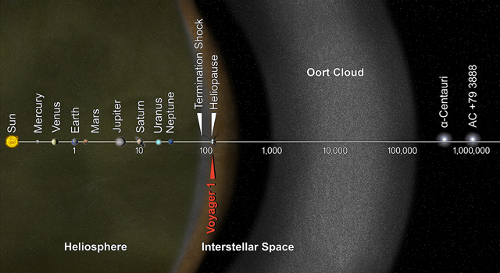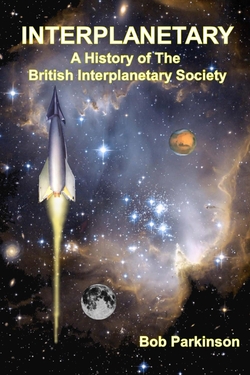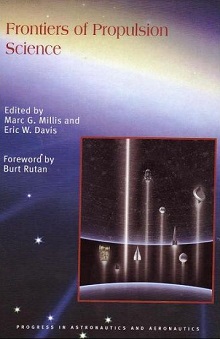Tracking Voyager 1 outbound for the past decade has been at times anti-climactic. Had the spacecraft reached interstellar space or hadn’t it, and how exactly would we know? The announcement last week that the milestone has been reached will forever mark August 25, 2012 as the date when a human-built object, still returning data, made the crossing. That it took a year of analysis only reminds us how much we have to learn about even this closest region of the space between the stars, where some interactions with the Sun continue.
“We have been cautious because we’re dealing with one of the most important milestones in the history of exploration,” said Voyager project scientist Ed Stone of the California Institute of Technology in Pasadena. “Only now do we have the data — and the analysis — we needed.”

Image: I use this image — or one much like it — all the time in my talks because it puts huge Solar System distances in perspective. The scale bar is measured in astronomical units (AU), with each set distance beyond 1 AU representing 10 times the previous distance. Each AU is equal to the distance from the Sun to the Earth. It took from 1977 to 2013 for Voyager 1 to reach the edge of interstellar space. Credit: NASA/JPL-Caltech
The caution has certainly been justified. Voyager 1’s plasma spectrometer — able to measure the ionized gas, or plasma, that essentially inflates the heliosphere — stopped working all the way back in 1980. The direction of magnetic field lines emanating from the Sun became became the alternative marker, since solar plasma and interstellar plasma were expected to differ in direction. Another marker: The level of charged particles inside the heliosphere should drop and the level of galactic cosmic rays should rise when the heliosphere was truly crossed.
Last summer brought changes beginning in May and accelerating in July with a jump in the number of outside particles and a drop in the charged particles from the Sun. Confusingly, the magnetic field direction had not changed — was the spacecraft still inside the heliosphere? A solar storm early in 2012 may have furnished the answer. Leading the plasma wave science team, Don Gurnett and Bill Kurth (University of Iowa) realized that radio activity observed earlier in the mission had been the result of interstellar plasma encountering bursts of solar material.
The oscillations caused by such events should be observable when Voyager 1 is surrounded by interstellar plasma, and plasma oscillations in the spring of this year had the signature of that plasma, evidently the outflow from the March, 2012 solar flare activity. The scientists made the call based on the observed electron density of the plasma, which is higher in the interstellar medium. Working back through the data, the duo could pin the onset of these interactions to August of 2012, consistent with the earlier changes in charged particles and doubtless related to the burst of solar activity that set the plasma in motion. While amidst interstellar plasma, the spacecraft was still feeling some influence from the Sun. Let me quote Stone again on this:
“Now that we had actual measurements of the plasma environment – by way of an unexpected outburst from the sun – we had to reconsider why there was still solar influence on the magnetic field and plasma in interstellar space. The path to interstellar space has been a lot more complicated than we imagined.”
NASA is now saying that by August 25 the spacecraft had entered the interstellar region for good, an indication that the heliopause had been crossed. The Voyager team is in agreement that the spacecraft is in interstellar space, although Stone refers to it as “a mixed, transitional region,” and we still see some solar influence, possibly including the unchanged direction of the magnetic field, which is puzzling. Voyager 1 seems to be illustrating what we have been learning for the past sixty years, that the Solar System and its surroundings are much more varied and diffuse than we previously thought. We once conceived of our system as a place of nine planets and a belt of rocky debris. Now we know about numerous small worlds in the Kuiper Belt, a second band of rock and icy objects, and have re-tooled the very definition of the word ‘planet.’ We’ve also learned we’re surrounded by trillions of comets.
That latter point deserves some attention, for the numerous headlines talking about Voyager 1’s departure from the Solar System reflect a continuing misunderstanding about what the system actually is. The Oort Cloud is widely accepted as the home of long-period comets, occasionally jolted by gravitational interactions into sending a new comet into a Sun-grazing orbit. To leave the Solar System, we have to speak of going to a place where the Sun’s gravity no longer dominates, and that could take us out 100,000 AU or more. Voyager 1’s passage through the Oort Cloud will be measured in tens of thousands of years. In 40,000 years, Voyager 1 will be closer to the star AC +79 3888 than to our own Sun.
One of those headlines mistakenly saying that Voyager 1 had left the Solar System occurred in the Washington Post, but the article nonetheless contained this gem:
Launched in 1977, the Voyager’s computing power was impressive for its time. The spacecraft was designed to run most of its operations itself, since the billions of miles separating it and Earth make communication laggy. To accomplish that, Voyager has three interconnected computer systems: one to control the craft’s flight and altitude, another to control its instruments, and a third to manage the first two. The computers can process about 8,000 instructions per second — a fraction of the capability of your smartphone, which handles upwards of 14 billion each second. With memory measured in kilobytes, they can hold only hold a few thousand words worth of text.
We haven’t left the Solar System, but at 121 AU we’ve punched through the heliopause and are in a region where our spacecraft is surrounded by material from other stars rather than being dominated by plasma from the Sun. The achievement is colossal: We launched the Voyagers in 1977 on a mission designed to study specific planetary targets, with no expectations that they could be pushed to become our first interstellar probes. Their data are stored on 8-track digital tape recorders and broadcast back to Earth with a 23-watt signal. That Voyager 1 has now managed the journey speaks to the quality of its construction and the dedication of the teams that have monitored it over the decades. What more will it tell us before it falls finally silent?
The paper is Gurnett, Kurth et al., “In Situ Observations of Interstellar Plasma With Voyager 1,” published online in Science 12 September 2013 (abstract).
Addendum: This just in from Jim Benford, who has been calculating when Voyager 2 and New Horizons will cross into interstellar space:
New Horizons is going the same direction as Voyager 2, as projected onto the ecliptic, but Voyager 2 is going south of the plane, New Horizons staying approx in the plane. It’s headed toward Sagittarius.
- If the ISM is the same distance as Voyager 1 found it (122 AU), New Horizons will take 30 years to reach it. [New Horizons is going 3.165 AU/yr, is 27.35 AU out].
- Similarly, if the ISM is the same distance as Voyager 1 found it, Voyager 2 will reach the ISM in 4.9 years.



Best Voyager-related Tweet was from James R. Davenport: “@NASAVoyager changes relationship status from “With Sol” to “It’s Complicated.””
(https://twitter.com/jradavenport)
It is unfotunate that we cant put Voyager into Sleep mode. The power systems RTG, does not have a standby power setting. The power comes out wether you used it or not, since radioactive decay is not something we can’t turn off.
Besides minimal instrumentation and communcation, I pressume any excess power is used for heating. (does it require a bit of heating, or is an
outside temperature of near Absolute zero something it can withstand?)
If you were to redesign the spacecraft to use beamed microwave power from Earth orbital distance (with suitable batteries/capacitors) How many Kilowatts would be needed and what size would your refocusing lens need to be, so that voyager could function at it’s present distance with beamed power. I get the feeling the kilowattage required is closer to the megawatt range, and that refocuser would need to be the size of a modest solar sail, 300 m.
So are we safe from keeping Ballard from attempting to retrieve this object?
The obvious reference is http://xkcd.com/1189/
Just an FYI: Neil Armstrong died on August 25, 2012.
Rob Flores said on September 16, 2013 at 13:55:
“So are we safe from keeping Ballard from attempting to retrieve this object?”
Though the Voyager Interstellar Record was designed for hopefully proper interpretation by an ETI sophisticated enough to find the probe and its information package, there is also a hope – and a much higher chance – that future human space explorers may retrieve one or all of the deep space probes to have an undoubtedly rare artifact from the earliest days of the human Space Age.
Another important aspect of the Golden Record is that it may also provide information about humanity in the late 20th Century that our distant descendants may not be able to find elsewhere. Thus the high importance that every deep space mission carry knowledge about its makers and their place in the Universe for future finders, human or otherwise.
Apparently the distance to the heliopause is wildly different in different directions, according to the graphic on this page:
http://voyager.jpl.nasa.gov/mission/index.html
Presumably the distance varies also with the strength of the Sun’s magnetic field, which varies in time during the solar cycle.
Using the heliopause to define a boundary between the Solar System and interstellar space therefore seems to be unhelpful, particularly, as you noted above, since there are large numbers of Solar System bodies orbiting further out. To my mind, the most significant milestone in this area is the acceleration of a spacecraft from negative to positive total energy: after their Jupiter flybys, Pioneers 10 and 11, Voyagers 1 and 2 and New Horizons were no longer gravitationally bound to the Sun.
Further discussion of these issues on the I4IS blog:
http://www.interstellarindex.com/2013/04/24/when-will-voyager-1-leave-the-solar-system/
Stephen
I am always confused by the definition of ‘interstellar’ space’ for voyager.
For instance there may be a trillion Oort cloud comets , which are out side the Sun’s heliosphere , which put them in ‘interstellar’ space, yet they are bound to the sun (except for perturbations by passing stars) (or those incoming Oort cloud long period comets which are ejected on unbound orbits , mostly by Jupiter).
So maybe one has to say Voyager is both unbound from the sun and outside the heliosphere.
What space is the Sun in? Or any star with or without planets in it’s on stellar outflow (black dwarfs wouldn’t have one) what space are they in?
An appropriate reference here also appears to be:
122 AU = 70.5 days at 0.01 c or just 3k km/s.
What speed can a sundiver style solar or mag sail mission reach with today’s materials? Anyone willing to try?
Review: Dreams of Other Worlds
The venerable Voyager 1 spacecraft was back in the news last week with word that it had passed into interstellar space. Jeff Foust reviews a book that looks at Voyager and a number of other astronomy and planetary science missions, putting their development and scientific results into a broader context.
Monday, September 16, 2013
http://www.thespacereview.com/article/2364/1
Solar Sails, Vulpetti et al. suggests that the sail might reach 70 km/s with a fast trajectory using the sun. This is considerably lower that the 3000 km/s. You would therefore need beamed power to boost the sail velocity, something we do not have today.
ljk: that’s a fitting coincidence with the passing of Neil Armstrong. One great story ends just as another is beginning.
@Al Jackson: I think the definitions have confused a lot of people and it is tricky for those of us in the media. I can understand why a lot of newspapers and websites have said it has left the Solar System, although this was also an ideal time to educate people on what the heliosphere and the solar wind is, so maybe some journalists missed a trick there. Voyager 1 has escaped the Sun’s magnetic influence (although the solar wind can still leak out into interstellar space) but not yet its gravitational sphere of influence (although it does have escape velocity). But remember once upon a time the Solar System was just six planets; then it grew to include Uranus, then Neptune, then Pluto and the Kuiper Belt and finally the Oort Cloud. Back when Galileo was discovering Jupiter’s moons, or even when Ernst Öpik and Jan Oort developed their hypothesis of the Oort Cloud in the 1930s and 1950 respectively, the solar wind remained undiscovered. So given that history it’s no surprise that the old definition of Solar System is incompatible with the size and shape of the heliosphere. It seems weird to say that part of the Solar System is in interstellar space, but that’s where the Oort Cloud is.
What solar system will New Horizons and its solid upper stage fly by millennium from now?
“Last summer brought changes beginning in May and accelerating in July”
Clearly that was written from another planet, for Earth aphelion is 5 July. With solar insolation levels down 7%, global temperature should drop a couple of degrees. That effect should hold up to about the tropic of cancer. You have to go way further north to find a small area that has a noticeable local summer in the midst of our planetary winter outside of which the above statement makes no sense at all.
Whoops — sorry for my hemispheric insensitivity!
I should actually correct my above statement – there were indications of the solar wind through studies of the Northern Lights at the turn of the twentieth century thanks to the work of people like Kristian Birkeland, but the point remains it and the heliosphere were not detected until the Space Age.
GEORGE DVORSKY
Today September 20, 2013 6:20am 2,949g1136LE
New message to aliens could be uploaded to New Horizons spacecraft
Astronomical artist Jon Lomberg — the same guy who helped develop the Voyager Interstellar record back in 1977 — is launching a new initiative to persuade NASA to upload a new message to the New Horizons spacecraft once its mission to Pluto is complete. He’s calling it Voyager Record 2.0.
As it stands, New Horizons doesn’t have any Voyager-like message on board. The spacecraft is currently 3.1 billion miles (5 billion km) from Earth on a mission to explore Pluto and its moons. But according to Lomberg, it’s not too late to upload a message into its databanks via a radio transmission— a digital message that could, in theory, be intercepted and decoded by an extraterrestrial intelligence. Because, like Voyager, New Horizons will eventually make its way into interstellar space.
ABC reports:
This Sunday (September 22 at 9 am EST) Lomberg formally launches the New Horizons Message Initiative (NHMI). Its goal is to persuade NASA to transmit an updated “portrait of Planet Earth” to the spacecraft’s computer memory after its active mission of Pluto is complete.
“There is no room on the computer memory for our message until all the data from the Pluto encounter have been downloaded,” said Lomberg.
He has the support of an international advisory board of more than 60 scientists, engineers, journalists, artists and ordinary people. Signatories include Jill Tarter, best known for her work with Search for Extraterrestrial Intelligence (SETI) and former Young Australian of the Year, astrophysicist Bryan Gaensler.
“I feel cheated that the great stories and exploration of space happened before my time,” said Gaensler. “If I’d been a prominent astronomer in the ’70s I would love to have participated in what Voyager and Pioneer carry with them outwards. This is my generation’s chance … to take our message outwards too.”
Interestingly, Lomberg is hoping to crowd-source the message. After holding a worldwide search for materials, finalists will be selected through online voting. Of course, sending messages to extraterrestrial intelligences (METI) doesn’t come without its potential risks.
Full article here:
http://io9.com/new-message-to-aliens-could-be-uploaded-to-new-horizons-1354922031
New Horizons Message Initiative (NHMI) Web site:
http://www.newhorizonsmessage.com/
Basically it will make up for the lack of effort to create a METI information package for the probe by the mission team. Now New Horizons may finally be worthy of being a representative of humanity in the wider Milky Way galaxy.